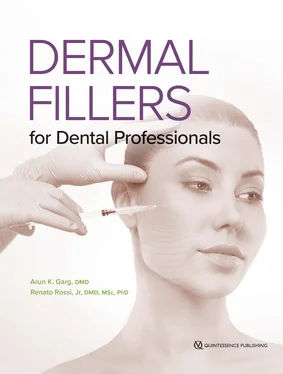Permanent Fillers
The “holy grail” among dermal filler manufacturers is a product that boasts the safety profile of HAs but without resorption, and promises a permanent (5+ years) improvement in facial appearance. Today, only one agent has been shown to approach that ideal.
Polymethylmethacrylate
To date, the only “permanent” filler material approved by the FDA is composed of polymethylmethacrylate (PMMA), a nonbiodegradable, biocompatible, synthetic polymer that is also used in various medical materials and devices, including dental prostheses. A PMMA dermal filler is made of tiny microspheres carried in a collagen gel. When injected, it initiates a foreign-body reaction that eventually leads to the production of new collagen. The collagen carrier provides immediate volume and lift in the short term, while the nonbiodegradable PMMA microspheres have a long-term “bulking” effect. 20
Bellafill (Suneva Medical) was the first (and so far only) PMMA dermal filler to be FDA cleared (under a different trade name) for the correction of folds and wrinkles (Fig 3-12). It consists of 20- to 50-µm microspheres of PMMA suspended in a bovine collagen gel carrier, which acts as a glue, preventing the microspheres from clumping and allowing for new tissue ingrowth. Because the collagen is derived from an animal source, skin allergy testing is required 4 weeks prior to treatment. The collagen carrier is absorbed within 1 month of injection and replaced by the patient’s connective tissue within 3 months. 21 The inherent downside to a “permanent” filler is that it is less forgiving when mistakes are made or complications arise.

FIG 3-12Bellafill is a unique, dual-acting dermal filler indicated for deep folds in the midface and lower face and to treat moderate to severe pitted atrophic facial acne scars. Composed of sterile PMMA microspheres suspended in a purified bovine collagen gel carrier, it works by adding both immediate lift from the collagen and long-term (up to 5 years) volume correction from the production of new collagen supported by the microsphere matrix. Because it contains bovine collagen, a skin test is required before use.
Conclusion
Understanding the active components in dermal fillers and their properties allows clinicians to make informed decisions about the products that are currently available and new ones on the horizon. Obviously, clinical factors are equally important. When selecting a dermal filler product, key factors include treatment area, degree of volume loss, and longevity. Furthermore, the rheologic properties of each dermal filler material narrow its applicability. In general, a thinner, more supple filler is used for minor rhytids, lips, scars, and frown lines, while a structure-oriented filler is best for high-volume-loss rhytids, chins, and malar regions. All of these qualities are discussed in detail in later chapters, which cover the step-by-step injection procedures, beginning with the esthetic consultation.
References
1.Day DJ, Littler C, Swift RW, Gottlieb S. The wrinkle severity rating scale: A validation study. Am J Clin Dermatol 2004;5:49–52.
2.Cheng L-Y, Sun X-M, Tang M-Y, Jin R, Cui W-G, Zhang Y-G. An update review on recent skin fillers. Plast Aesthet Res 2016;3:92–99.
3.Funt D, Pavicic T. Dermal fillers in aesthetics: An overview of adverse events and treatment approaches. Clin Cosmet Investig Derm 2013;6:295–316.
4.Lin ZY, Shah V, Dhinakar A, Yildirimer L, Cui W-G, Zhao X. Intradermal fillers for minimally invasive treatment of facial aging. Intradermal fillers for minimally invasive treatment of facial aging. Plast Aesthet Res 2016;3:72–82.
5.Werschler WP, Narurkar VN. Facial volume restoration: Selecting and applying appropriate treatments. Technique poster. Cosmet Dermatol. 2006;19(suppl 2):S1.
6.Van Loghem J, Yutskovskaya YA, Werschler WP. Calcium hydroxylapatite: Over a decade of clinical experience. J Clin Aesthet Dermatol 2015;8:38–49.
7.Dastoor SF, Misch CE, Wang H-L. Dermal fillers for facial soft tissue augmentation. J Oral Implantol 2007;33:191–204.
8.Urdiales-Gálvez F, Delgado NE, Figueiredo V, et al. Treatment of soft tissue filler complications: Expert consensus recommendations. Aesthetic Plast Surg 2018;42:498–510.
9.Bacigalupi R, Clark J, Lupo MP. An overview of injectable fillers with special consideration to the periorbital area. Cosmet Dermatol 2012;25:421–426.
10.American Society of Plastic Surgeons. 2018 Plastic Surgery Statistics Report. https://www.plasticsurgery.org/documents/News/Statistics/2018/cosmetic-procedure-trends-2018.pdf. Accessed 21 April 2020.
11.Glogau RG. Fillers: From the past to the future. Semin Cutan Med Surg 2012;31:78–87.
12.Mansouri Y, Goldenberg G. Update on hyaluronic acid fillers for facial rejuvenation. Cutis 2015;96:85–88.
13.Fagien S, Bertucci V, von Grote E, Mashburn JH. Rheologic and physicochemical properties used to differentiate injectable hyaluronic acid filler products. Plast Reconstr Surg 2019;143:707e–720e.
14.Obi G, International Society of Plastic and Aesthetic Nurses. How to choose a filler or neuromodulator to treat your patients’ aesthetic concerns. https://ispan.org/meeting/multimedia/files/2018/Presentations/1130-Obi.pdf. Accessed 21 April 2020.
15.Zollino I, Carinci F. The use of poly-L-lactic acid filler in facial volume restoration: A review. Open Access Dermatol 2014;2(1):1–3.
16.Vleggaar D, Fitzgerald R, Lorenc ZP, et al. Consensus recommendations on the use of injectable poly-L-lactic acid for facial and nonfacial volumization. J Drugs Dermatol 2014;13(suppl 4):s44–s51.
17.Fontes T, Brandão I, Negrão R, Martins MJ, Monteiro R. Autologous fat grafting: Harvesting techniques. Ann Med Surg (Lond) 2018;36:212–218.
18.Simonacci F, Bertozzi N, Grieco MP, Grignaffini E, Raposio E. Procedure, applications, and outcomes of autologous fat grafting. Ann Med Surg (Lond) 2017;20:49–60.
19.Cho K-H, Uthaman S, Park I-K, Cho C-S. Injectable biomaterials in plastic and reconstructive surgery: A review of the current status. Tissue Eng Regen Med 2018;15:559–574.
20.Lemperle G, Knapp TR, Sadick NS, Lemperle SM. Artefill permanent injectable for soft tissue augmentation: I. Mechanism of action and injection techniques. Aesthetic Plast Surg 2010;34:264–272.
21.Dayan S, Bassichis BA. Facial dermal fillers: Selection of appropriate products and techniques. Aesthet Surg J 2008;28:335–347.
Конец ознакомительного фрагмента.
Текст предоставлен ООО «ЛитРес».
Прочитайте эту книгу целиком, купив полную легальную версию на ЛитРес.
Безопасно оплатить книгу можно банковской картой Visa, MasterCard, Maestro, со счета мобильного телефона, с платежного терминала, в салоне МТС или Связной, через PayPal, WebMoney, Яндекс.Деньги, QIWI Кошелек, бонусными картами или другим удобным Вам способом.













